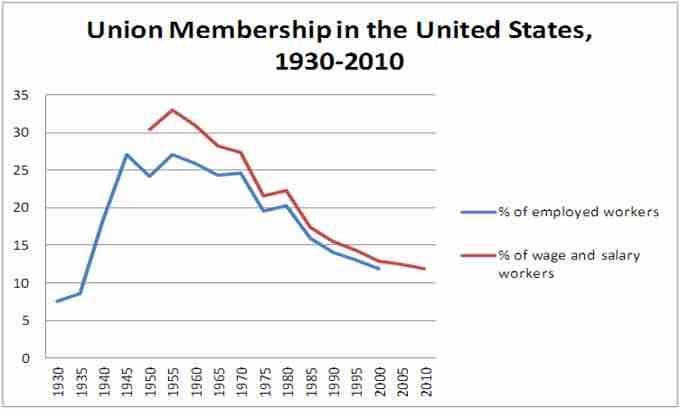Labor unions are legally recognized as representatives of workers in many industries in the United States. Labor union's activism centers on collective bargaining over wages, benefits, and working conditions for their membership, and on representing their members in disputes with management over violations of contract provisions.
Most unions in America are aligned with one of two larger umbrella organizations: the AFL-CIO created in 1955, and the Change to Win Federation, which split from the AFL-CIO in 2005. Both advocate policies and legislation on behalf of workers in the United States and Canada, and take an active role in politics. The AFL-CIO is especially concerned with global trade issues.
Union Membership
To join a traditional labor union, workers must either be given voluntary recognition from their employer or have a majority of workers in a bargaining unit vote for union representation. In either case, the government must then certify the newly formed union. Other forms of unionism include minority unionism, solidarity unionism, and the practices of organizations such as the Industrial Workers of the World, which do not always follow traditional organizational models.
Union membership had been declining in the US since 1954. In 2007, the Labor Department reported the first increase in union memberships in 25 years and the largest increase since 1979. Most of the recent gains in union membership have been in the service sector while the number of unionized employees in the manufacturing sector has declined. Although most industrialized countries have seen a drop in unionization rates, the drop in union density (the unionized proportion of the working population) has been more significant in the United States than elsewhere. Dropping unionization rates cannot be attributed entirely to changing market structures; scholars have shown the tremendous complexity inherent in explaining the decline of union density.
Although much smaller compared to their peak membership in the 1950s, American unions remain an important political factor, both through mobilization of their own memberships and through coalitions with like-minded activist organizations around issues such as immigrant rights, trade policy, health care, and living wage campaigns. To fight employer anti-union programs, unions are currently advocating new "card check" federal legislation that would require employers to bargain with a union if more than 50% of workers signed forms, or "cards," stating they wish to be represented by that union, rather than waiting 45 to 90 days for a federally-supervised a secret ballot election during which time employers can fire, harass and generally make life miserable for pro-union employees.

Union Membership in the United States
This diagram shows the rise and fall of union membership in the United States.